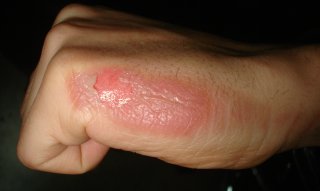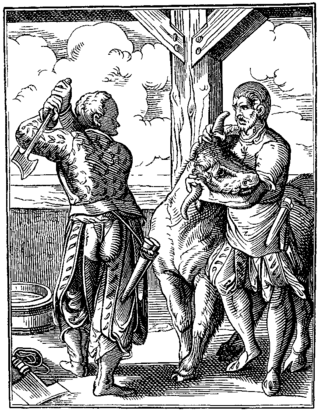
A forge is a type of hearth used for heating metals, or the workplace (smithy) where such a hearth is located. The forge is used by the smith to heat a piece of metal to a temperature at which it becomes easier to shape by forging, or to the point at which work hardening no longer occurs. The metal is transported to and from the forge using tongs, which are also used to hold the workpiece on the smithy's anvil while the smith works it with a hammer. Sometimes, such as when hardening steel or cooling the work so that it may be handled with bare hands, the workpiece is transported to the slack tub, which rapidly cools the workpiece in a large body of water. However, depending on the metal type, it may require an oil quench or a salt brine instead; many metals require more than plain water hardening. The slack tub also provides water to control the fire in the forge.

In livestock agriculture and the meat industry, a slaughterhouse, also called an abattoir, is a facility where livestock animals are slaughtered to provide food. Slaughterhouses supply meat, which then becomes the responsibility of a meat-packing facility.
Liebeck v. McDonald's Restaurants, also known as the McDonald's coffee case and the hot coffee lawsuit, was a highly publicized 1994 product liability lawsuit in the United States against the McDonald's restaurant chain.

A burn is an injury to skin, or other tissues, caused by heat, cold, electricity, chemicals, friction, or ultraviolet radiation. Most burns are due to heat from hot liquids, solids, or fire. Burns occur mainly in the home or the workplace. In the home, risks are associated with domestic kitchens, including stoves, flames, and hot liquids. In the workplace, risks are associated with fire and chemical and electric burns. Alcoholism and smoking are other risk factors. Burns can also occur as a result of self-harm or violence between people (assault).

A butcher is a person who may slaughter animals, dress their flesh, sell their meat, or participate within any combination of these three tasks. They may prepare standard cuts of meat and poultry for sale in retail or wholesale food establishments. A butcher may be employed by supermarkets, grocery stores, butcher shops and fish markets, slaughter houses, or may be self-employed.
A hide or skin is an animal skin treated for human use. The word "hide" is related to the German word Haut, which means skin. The industry defines hides as "skins" of large animals e.g. cow, buffalo; while skins refer to "skins" of smaller animals: goat, sheep, deer, pig, fish, alligator, snake, etc. Common commercial hides include leather from cattle and other livestock animals, buckskin, alligator skin and snake skin. All are used for shoes, clothes, leather bags, belts, or other fashion accessories. Leather is also used in cars, upholstery, interior decorating, horse tack and harnesses. Skins are sometimes still gathered from hunting and processed at a domestic or artisanal level but most leather making is now industrialized and large-scale. Various tannins are used for this purpose. Hides are also used as processed chews for dogs or other pets.

A bathtub, also known simply as a bath or tub, is a container for holding water in which a person or another animal may bathe. Most modern bathtubs are made of thermoformed acrylic, porcelain-enameled steel or cast iron, or fiberglass-reinforced polyester. A bathtub is placed in a bathroom, either as a stand-alone fixture or in conjunction with a shower.

Scalding is a form of thermal burn resulting from heated fluids such as boiling water or steam. Most scalds are considered first- or second-degree burns, but third-degree burns can result, especially with prolonged contact. The term is from the Latin word calidus, meaning hot.

Shen Zhu or God Pig, sometimes known as Holy pig, are pigs that have been chronically fattened for use in Hakka religious and cultural ceremonies, such as the Yimin Festival and the Lunar New Year celebration in Sanxia, northern Taiwan. Pigs are fattened in a process similar to gavage to make them as large as possible in preparation for contests and awards at the festival. The heaviest pig is declared the winner and the owner may receive a prize. The winning pig and other pigs entered into the contest are ritually killed as a sacrifice to the City God or a local deity, one popular temple that continues this tradition is Changfu Temple which is dedicated to the deified Buddhist monk Master Qingshui. However, contrary to popular belief, the pig is not sacrificed to Master Qingshui, but to the mountain deities.
Scalded milk is dairy milk that has been heated to 83 °C (181 °F). At this temperature, bacteria are killed, enzymes in the milk are destroyed, and many of the proteins are denatured. Since most milk sold today is pasteurized, which accomplishes the first two goals, milk is typically scalded to increase its temperature, or to change the consistency or other cooking interactions due to the denaturing of proteins.

Animal slaughter is the killing of animals, usually referring to killing domestic livestock. It is estimated that each year, 80 billion land animals are slaughtered for food. Most animals are slaughtered for food; however, they may also be slaughtered for other reasons such as for harvesting of pelts, being diseased and unsuitable for consumption, or being surplus for maintaining a breeding stock. Slaughter typically involves some initial cutting, opening the major body cavities to remove the entrails and offal but usually leaving the carcass in one piece. Such dressing can be done by hunters in the field or in a slaughterhouse. Later, the carcass is usually butchered into smaller cuts.

A thermostatic mixing valve (TMV) is a valve that blends hot water with cold water to ensure constant, safe shower and bath outlet temperatures to prevent scalding.
A scalding house was the office in a medieval household responsible for scalding the carcasses of animals, as well as utensils. It was also the room in which this activity took place. It was headed by a scalder. The office was subordinated to the kitchen, and existed as a separate office only in larger households. It was closely connected with other offices of the kitchen, such as the saucery and the scullery.

Sun scald is the freezing of bark following high temperatures in the winter season, resulting in permanent visible damage to bark. Fruits may also be damaged. In the northern hemisphere, it is also called southwest injury.

Pig farming, pork farming, or hog farming is the raising and breeding of domestic pigs as livestock, and is a branch of animal husbandry. Pigs are farmed principally for food and skins.

Pig slaughter is the work of slaughtering domestic pigs to obtain pig meat (pork). It regularly happens as part of traditional and intensive pig farming, which is both a common economic activity as well as a traditional feast in some European and Asian countries.
A thermal burn is a type of burn resulting from making contact with heated objects, such as boiling water, steam, hot cooking oil, fire, and hot objects. Scalds are the most common type of thermal burn suffered by children, but for adults thermal burns are most commonly caused by fire. Burns are generally classified from first degree up to fourth degree, but the American Burn Association (ABA) has categorized thermal burns as minor, moderate, and major, based almost solely on the depth and size of the burn.

Pork rind is the culinary term for the skin of a pig. It can be used in many different ways.
The Large White Ulster, or Ulster White, was a breed of domestic pig. Primarily bred for bacon production, it was the favoured breed of farmers in the north of Ireland up until the mid 20th century.

On 23 October 2016, a five-year-old boy was pronounced dead at a children's hospital in Singapore. He was found to have been a victim of child abuse by his conservative parents Azlin binte Arujunah and Ridzuan bin Mega Abdul Rahman for months leading up to his death. This involved both Azlin and Ridzuan using boiling hot water to scald the boy on several occasions, inflicting severe burns and scald injuries which caused the boy to die in hospital weeks after the first of the four scalding incidents. The couple was later arrested and charged with murder. To protect his surviving siblings' identities and their privacy, the boy was not named in the media.















